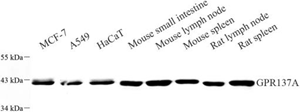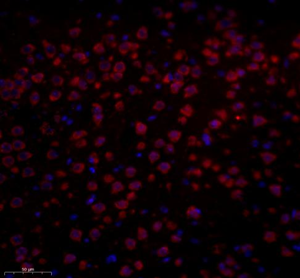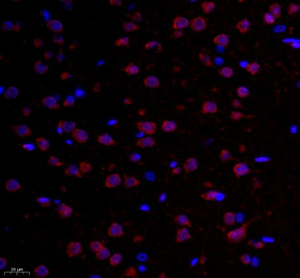Anti-GPR137A Rabbit pAb (100 μl)
| Reactivity: | H,M,R & M,R |
| Applications: | WB & IHC/IF |
| Host Species: | Rabbit |
| Clonality: | Polyclonal |
| Full Name: | GPR137A rabbit polyclonal antibody |
Gene Name: | Integral membrane protein GPR137 |
Synonyms: | Transmembrane 7 superfamily member 1-like 1 protein, Gpr137, Tm7sf1l1, C11orf4 |
Immunogen: | Recombinant protein corresponding to Mouse GPR137A |
Isotype: | IgG |
Purity: | Affinity purification |
Subcellular location: | Lysosome |
Predicted MW. | 44 kDa |
Observed MW. | 44 kDa |
Uniprot ID: | Q96N19, Q80ZU9 |
Product Usage Information
Applications | Species | Dilution | Positive Sample |
WB | Human, Mouse, Rat | 1: 500-1: 1000 | small intestine, lymph node, spleen |
IHC/IF | Mouse, Rat | 1: 650-1: 6500 | corpus striatum, prefrontal lobe |
Background
G protein-coupled receptors (GPRs) are highly related to oncogenesis and cancer metastasis. G protein-coupled receptor 137 (GPR137) was initially reported as a novel orphan GPR about 10 years ago. GPR137 is ubiquitously expressed in the central nervous system (CNS), mainly in the hippocampus . GPR137 is involved in the progression of human glioma, suggesting GPR137 as a potential oncogene of glioma cells . Recent study shows that GPR137 plays an important role in colon cancer cell proliferation .
Images
 | Western blot analysis of GPR137A (GB112370) at dilution of 1: 500 |
 | Immunofluorescence of paraffin embedded mouse prefrontal lobe using GPR137A (GB112370) at dilution of 1: 650 (300x lens) |
 | Immunofluorescence of paraffin embedded rat corpus striatum using GPR137A (GB112370) at dilution of 1: 6500 (400x lens) |
Storage
| Storage | Store at -20°C for one year. Avoid repeated freeze/thaw cycles. |
| Storage Buffer | PBS with 0.02%sodium azide,100 μg/ml BSA and 50% glycerol. |
